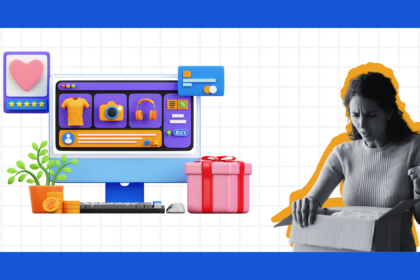My perception of building an e-commerce brand looks fun. All you need is to create a specialized domain with your brand name, work with different teams like marketing, sales, and customer experience to understand how you can further attract customers, sell not just products but something that brings out your own identity, etc. Looks really “fun”.
E-commerce merchants running a business IRL might disagree with me on this one as things are not as rosy as it sounds. There are challenges in the form of heavy competition, ever-changing consumer trends, and costs and other efforts required in brand building.
But that’s just the tip of the iceberg. The real problem lies in keeping things consistent and building the brand’s reputation. That means, having an established brand is not enough — you have to ensure that customers keep coming back to your store and talking positively about you. And that is rightly termed as ‘brand loyalty’.
What is Brand Loyalty?
Take Apple, for instance, their products may have certain ups and downs now and then but customers who have been using Apple’s products will almost always continue upgrading rather than changing brands. Yes, brand loyalty has a lot to do with building this level of ‘fan-following’.
Brand loyalty is simply customers’ taste and preference toward a specific brand to the extent that they keep choosing the same brand despite multiple brands in the fray.
But a competitive advantage isn’t the only reason why e-commerce brands must focus on building loyalty. There are far higher benefits for them in the form of:
- Increased chances of repeat purchases – Retained customers spend 5 – 25% more than new customers
- Increased brand reputation – Satisfied customers are more likely to share that experience with their friends and families and play a huge role in attracting more customers
- Increased cost savings – It is 5 times more expensive to attract a new customer than an existing one
Just like how a loyal customer tribe is crucial to brand building, a positive overall customer experience is a major contributor to brand loyalty.
At this stage, it is important to remember that most of your efforts to build customer loyalty take place after the customer makes a purchase. However, the post-purchase phase is notorious for multiple issues that can affect the customer experience when unattended. Thus, we’ve set this article’s focus primarily on post-purchase issues that can cause a bump in your brand loyalty efforts.
Without any further ado, let’s take a look at the e-commerce hiccups in the post-purchase that bust brand loyalty and how you can tackle them.
E-Commerce Hiccups That Bust Brand Loyalty And How You Can Tackle Them


1. Product-related issues
Customers today have high expectations for their purchases and you have no option but to strictly meet them in order to improve satisfaction. One of the major areas where customers have great expectations is the look and quality of the product they’ve purchased. In case it doesn’t match the image or description or if it is damaged/delivered broken, then their anticipation changes to disappointment, and leads to low confidence in your brand. To resolve such incidents, brands can take careful measures to provide images, videos, and descriptions of good quality that showcase the product as it is. Also, there are some definite ways to effectively handle damaged packages so that you can recover your lost dollars and your customers are no longer frustrated.
2. Shipping and fulfillment issues
Up to 20% of shipments face issues such as late delivery, attempted-failed delivery, lost or damaged in transit. When left unattended, these issues have the power to hurt brand loyalty as your customers’ purchases mean so much to them and they’ve anticipated long enough to get their hands on their orders. And when that order doesn’t make it to them intact or on time, your customers are set on a course of disappointment and lose trust in your brand. Tracking your parcels, particularly in real-time, can really help you stay aware of any issues with your packages. You can also take it a step further and communicate the same with your customers to mitigate their frustration.
3. Sub-par customer service
Issues are inevitable and customers slowly seem to have an understanding of it. But that doesn’t mean you take advantage and leave things as they are. This is because proactive customer service is a tactical CX differentiator in the competitive e-commerce battlefield. In case of issues with their orders, customers expect you to deal with it proactively or at least, let them know at the earliest and offer favorable solutions. You can also be proactive while catering to customer inquiries and needs. Remember, just having being reactive or, for worse, not responding to things at this level leads to a frequent bombardment of customer queries, which leads to customers getting frustrated and dropping off.
4. Inconvenient returns/exchanges
If handled correctly, e-commerce returns have the potential to encourage repeat purchases from customers who have faced issues with their orders. However, most businesses see returns as a burden and a dent in their image and unintentionally leave them out. This can hurt your repeat business opportunities in more ways than one:
- A complicated and inconvenient returns process that lowers customer confidence in shopping with your brand
- The lack of flexible options prevents returns from being turned into exchanges, leading to lower repeat sales and extra costs in the form of refunds.
5. Poor data security
If there’s something that customers prioritize more than their orders, it’s the level of data security with the brands they shop with. For instance, despite being concerned, customers trust the brand in securing their data when they provide it in return for more personalized experiences. However, if there are any lapses in the brand’s security measures that are discovered later and the customers’ data goes out in the wild, the level of trust that the brand has built with the customer gets lost in an instant. If you’re wondering how to get started with data security, here are some things you can follow for a start:
- Assure your customers of your store’s cybersecurity
- Be transparent with customers while getting data from them. You can also go a step further and tell them exactly how this data will be put into effect.
6. Inconsistent branding efforts
An icing on the cake to a great CX is not missing out on chances to promote your brand wherever possible and catch the customer’s attention. However, most brands unintentionally leave out their customers’ post-purchase experiences once the order gets shipped. This includes a golden opportunity to brand customer touchpoints across the customer’s order tracking journey. With your brand no longer on your customers’ minds, repeat selling becomes a missed opportunity. To prevent this, all you have to do is start taking control of your customers’ order-tracking experiences and leverage each touchpoint to provide a brand-immersive experience.
7. Lack of personalized messaging
An extension of your branding efforts is to have product recommendations based on the customer’s recent purchase. Such a level of personalization can help in pushing customers sitting on the fence towards re-purchasing. However, with a lack of personalization, there is no room to appeal to the customer emotionally and thus, a lost chance to drive repeat sales. By initiating contextual communication based on the customer’s interests and creating tailor-made experiences for each of them, you can improve their overall satisfaction and increase conversions at a higher rate.
8. Ignoring feedback and reviews
With brands not tending to customers after they’ve made the purchase, there is clearly a dearth of insight into post-purchase performance and how customer loyalty efforts have been fruitful. Customers, too, look out for businesses that value their opinions. When their concerns get ignored, their positive feedback that was going to be private to you gets downgraded to a publicly posted negative review on social media channels. On the other hand, when you listen to what they want and direct efforts, you have a great chance to promote brand credibility.
Final word
Nothing helps brand building better than improving brand loyalty to the extent that first-time shoppers become repeat customers again and again, to the extent that they become brand advocates. Not only does this help in improving your profit rates (repeat customers tend to spend more) but it also helps you considerably reduce costs (acquiring new customers is an expensive process).
A great way to improve brand loyalty is to just ensure that your brand stays on the customers’ minds they’re having shopping needs. What better technique to do that than leveraging post-purchase touchpoints to provide memorable customer experiences and drive repeat purchases?
But brands not tending to post-purchase efforts create unwanted obstacles in improving brand loyalty and making things go bust. On the other hand, with the efforts to deliver delight with every shipment, customers abandoning brands has become a thing of the past.
Thus, it is time to offer memorable CX throughout delivery and returns and turn one-time shoppers into your brand’s BFFs. If you’re wondering where to start things, there are post-purchase automation platforms like LateShipment.com that can help you do just that.








